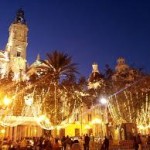You may have heard of Spanish referred to as a Romance language, but what does that actually mean? It’s nothing to do with  romance with a small r in the sense of being romantic (though the word has the same root, and many do think that Spanish does sound very romantic!), but rather it derives from Roman – the Romance languages are those that have their origins in the spoken Latin of Roman times.
romance with a small r in the sense of being romantic (though the word has the same root, and many do think that Spanish does sound very romantic!), but rather it derives from Roman – the Romance languages are those that have their origins in the spoken Latin of Roman times.
The Romance languages evolved between the 6th and 9th centuries after the fall of the Roman Empire. They include French, Italian, Portuguese, Romanian and Romansch (spoken in parts of Switzerland), but by far the most widely-spoken of the Romance languages is Spanish, with an estimated 410 million native speakers worldwide. English is not a Romance language because, while it does have many words derived from Latin, it is more heavily influenced by Northern European languages, and as such is classed as Germanic. That doesn’t mean, however, that you won’t recognise a single word as a beginner in Spanish. They may belong to different families but our two languages share as many as 40% of words from the same root and with similar meanings – called cognates – which makes learning Spanish much easier than tackling a completely unrelated language. They also form sentences in much the same way.
Here at Lingua Clinic, a private tutor will guide you every step of the way through your Spanish journey. We offer Spanish tuition in London in several different formats. You can choose private, group or intensive lessons, depending on your personal preferences and learning objectives. We cater for all levels of learners and can fit around your busy schedule. So say ¡Feliz año nuevo! and make Spanish your resolution for 2015.
 lamb or capon. Since 1962 the countdown to midnight has been broadcast on national TV from the clock on the Casa de Correos building in Puerta del Sol Square in Madrid where many people gather to see in the New Year in Spain’s equivalent of the UK’s broadcast from Big Ben.
lamb or capon. Since 1962 the countdown to midnight has been broadcast on national TV from the clock on the Casa de Correos building in Puerta del Sol Square in Madrid where many people gather to see in the New Year in Spain’s equivalent of the UK’s broadcast from Big Ben. the Immaculate Conception, or Inmaculada Concepcion. It might be a little early yet to wish people a happy Christmas (Feliz Navidad) but it’s never too early (or late!) to try your hand at the Spanish language. So, as we enter the festive season here are some ideas and vocabulary for you to try out.
the Immaculate Conception, or Inmaculada Concepcion. It might be a little early yet to wish people a happy Christmas (Feliz Navidad) but it’s never too early (or late!) to try your hand at the Spanish language. So, as we enter the festive season here are some ideas and vocabulary for you to try out. Domínguez Fernández to use the Spanish naming custom where, if you remember, Dominguez is the paternal surname and Fernández the maternal one.
Domínguez Fernández to use the Spanish naming custom where, if you remember, Dominguez is the paternal surname and Fernández the maternal one. none the less become one of the most influential contemporary Hispanic designers in her 15 years in the industry with her eclectic designs which have been described as “having the delicateness of a ballet dancer, while at the same time, the strength of a rock star”.
none the less become one of the most influential contemporary Hispanic designers in her 15 years in the industry with her eclectic designs which have been described as “having the delicateness of a ballet dancer, while at the same time, the strength of a rock star”. Carolina Herrera. Renowned for her personal style, she was named on the International Best Dressed list back in 1972 and inducted to its Hall of Fame in 1980. Her designs have been worn by First Ladies of the United States, of which she became a naturalised citizen in 2009, and her gowns have graced many a red carpet on actresses such as Renée Zellweger, Cameron Diaz and Nicole Kidman, and Colombian singer Shakira.
Carolina Herrera. Renowned for her personal style, she was named on the International Best Dressed list back in 1972 and inducted to its Hall of Fame in 1980. Her designs have been worn by First Ladies of the United States, of which she became a naturalised citizen in 2009, and her gowns have graced many a red carpet on actresses such as Renée Zellweger, Cameron Diaz and Nicole Kidman, and Colombian singer Shakira. Italian fashion house; the subject of our blog this week is Spanish fashion designer Ágatha Ruiz de la Prada. Born in 1960, she is also a high-ranking member of the Spanish nobility: one of the Grandees of Spain (Grandes de España), Marchioness of Castelldosrius and Baroness of Santa Pau.
Italian fashion house; the subject of our blog this week is Spanish fashion designer Ágatha Ruiz de la Prada. Born in 1960, she is also a high-ranking member of the Spanish nobility: one of the Grandees of Spain (Grandes de España), Marchioness of Castelldosrius and Baroness of Santa Pau. been a regular at New York Fashion Week and on catwalks around the world. The man behind the brand is Custo Dalmau, born Ángel Custodio Dalmau Salmón in Tremp, Lleida, Catalonia, in 1959.
been a regular at New York Fashion Week and on catwalks around the world. The man behind the brand is Custo Dalmau, born Ángel Custodio Dalmau Salmón in Tremp, Lleida, Catalonia, in 1959.
 who died on 20 October at the age of 82 after a long battle with cancer.
who died on 20 October at the age of 82 after a long battle with cancer. accents up and down the British Isles and indeed around the world. Spanish too, is spoken in many countries and, despite the work of the Royal Spanish Academy to standardise the language, it has its own variations from one country to the next. Nowhere are these differences more marked than in Argentina.
accents up and down the British Isles and indeed around the world. Spanish too, is spoken in many countries and, despite the work of the Royal Spanish Academy to standardise the language, it has its own variations from one country to the next. Nowhere are these differences more marked than in Argentina.